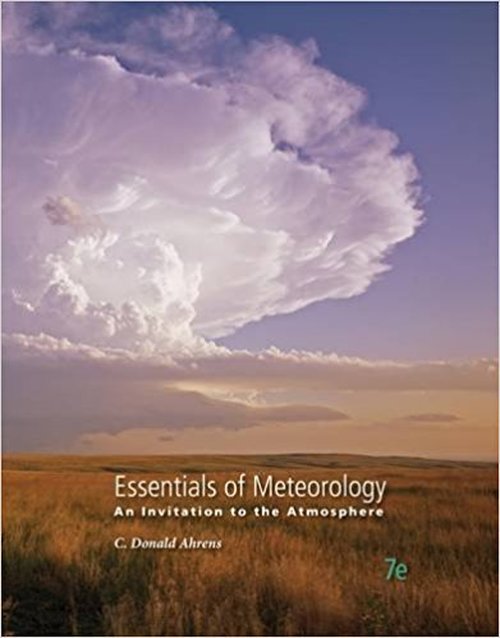Test Bank For Essentials of Meteorology-An Invitation to the Atmosphere 7th Edition by C. Donald Ahrens test bank
$55.00
Test Bank For Essentials of Meteorology-An Invitation to the Atmosphere 7th Edition by C. Donald Ahrens test bank
Category: Test Bank
INSTANT DOWNLOAD
What student Can You Expect From A Test Bank?
A test bank will include the following questions:
Description
Essentials of Meteorology-An Invitation to the Atmosphere 7th Edition by C. Donald Ahrens test bank
| ;A weak trough of low pressure found in the tropics and along which hurricanes occasionally form is called a(n) ____.
|
| ;Hurricane energy comes from the latent heat of ____.
|
| ;The skies in the center of a hurricane are often cloud free. This is because the air in the eye is ____.
|
| ;Pressure at the center of a hurricane is ____ than the surroundings at the surface and ____ than the surroundings aloft.
|
| ;As surface air rushes in toward the eye of a hurricane, the air expands and should cool. The main reason the surface air is not cooler around the eye is because ____.
|
| ;The vertical structure of the hurricane shows an upper-level ____ of air, and a surface ____ of air.
|
| ;During a hurricane, the heaviest rainfall occurs in the ____.
|
| ;At the periphery of a hurricane, the air is ____.
|
| ;Typhoons and hurricanes ____.
|
| ;By international agreement, what is the general term for all hurricane-type storms that originate over tropical waters?
|
| ;The skies in the center of a hurricane are often cloud free and surface air pressure is very low. This area is referred to as the ____.
|
| ;During a hurricane in the Northern Hemisphere, surface winds increase in speed as they blow ____ and ____ the center.
|
| ;The strongest winds in a hurricane are found ____.
|
| ;Hurricane winds rotate in a clockwise direction in ____.
|
| ;Storms that form in the tropics are given names when ____.
|
| ;As a northward-moving hurricane passes to the east of an area, surface winds should change from ____.
|
| ;Suppose the eye of a hurricane passed directly over you, and you survived the experience. If winds were from the northeast as the eyewall first approached you, from what direction did the winds blow when the eyewall reached you the second time?
|
| ;The main reason hurricanes don’t develop over the south Atlantic Ocean adjacent to South America is because the ____.
|
| ;Which region of the United States will most likely experience thunderstorms, hurricanes and tornadoes during the course of one year?
|
| ;Which environmental conditions are most favorable for hurricane formation?
|
| ;Hurricanes do not form ____.
|
| ;Hurricanes cannot form along the equator because ____.
|
| ;The main source of energy for a hurricane is the ____.
|
| ;Hurricanes dissipate when ____.
|
| ;The three stages of a developing hurricane (from the first stage to the third) are ____.
|
| ;Just before a storm is classified as a fully developed hurricane, it is in the ____ stage.
|
| ;The main feature distinguishing a hurricane from an ordinary tropical storm is that ____.
|
| ;A tropical storm is classified as a hurricane when ____.
|
| ;Which statement accurately describes hurricane naming conventions?
|
| ;Climate models predict that, as the world continues to warm, sea-surface temperatures in the tropics will rise. This may in turn ____.
|
| ;Most of the overall destruction caused by a hurricane is due to ____.
|
| ;Along a coastline, most hurricane damage is caused by ____.
|
| ;On the Saffir-Simpson scale, a category 5 storm would indicate ____.
|
| ;On the Saffir-Simpson hurricane scale, a hurricane with winds in excess of 155 mi/hr (135 knots) would be classified as a category ____ hurricane.
|
| ;The term storm surge refers to ____.
|
| ;The strongest winds in a hurricane heading westward toward Florida would most likely be found on the ____ side.
|
| ;Hurricane Katrina was classified as a Category 5, but as it moved towards the coast its rainbands near the center of the storm converged towards the eye, the storm weakened, and Katrina made landfall as a Category 3 hurricane. This weakening was primarily due to the phenomenon called ____.
|
| ;A hurricane warning ____.
|
| ;Which event indicates that a hurricane will likely strike your area within 24 hours?
|
| ;Scientists have tried to modify hurricanes by ____.
|
| ;Despite there being many differences in structure, if a weakening hurricane links up with an upper-level trough, it may actually become a mid-latitude cyclone.
|
| ;The terms typhoon and cyclone refer to the initial weaker stages in the development of a hurricane.
|
| ;Most hurricanes develop in warm tropical waters at the Equator even though the Coriolis force is zero there.
|
| ;Hurricane development is more likely when the trade wind inversion is well developed.
|
| ;There is a reduction in the number of Atlantic hurricanes during a major El Niño event.
|
| Instructions: Choose one answer from each pair of selections. |
| ;In most tropical regions the seasons are marked by differences in TEMPERATURE | PRECIPITATION.
|
| ;Hurricanes are WARM | COLD core lows.
|
| ;In a hurricane are the fastest winds and strongest thunderstorms found closer to the CENTER or the outer EDGE of the storm?
|
| ;Tropical cyclone development is most likely in a region where surface winds CONVERGE | DIVERGE.
|
| ;A hurricane’s intensity will INCREASE | DECREASE when the storm moves from the ocean onto land.
|
| ;Hurricane development is more likely when preexisting upper-level winds are STRONG | WEAK.
|
| ;Does the temperature difference between the ocean and cloud top determine the maximum strength of a storm in the HEAT ENGINE or the ORGANIZED CONVECTION representation of a hurricane?
|
| ;As westward-moving Atlantic hurricanes approach the east coast of the United States, they turn toward the NORTH | SOUTH
|
| ;In a hurricane moving northward along the Atlantic coast of the United States, the strongest winds will be on the EAST | WEST side.
|
| ;Cloud seeding has been used in attempts to INCREASE | DECREASE the diameter of the eye wall and thereby weaken hurricanes.
|
| ;What do forecasters use in place of isobars on ocean weather maps and why?
|
| ;In the vertical, where are winds the strongest in a hurricane versus in mid-latitude cyclones?
|
| ;Compare a hurricane’s eye to its eyewall.
|
| ;Describe what a trade wind inversion is.
|
| ;About one-fourth of the hurricanes that strike the United States produce tornadoes. Where do these tornadoes most often form in relation to the hurricane?
|
| ;Compare and contrast hurricanes and mid-latitude cyclones.
|
| ;Has the frequency and intensity of hurricanes have increased in recent years? Why or why not? Why might these patterns continue?
|
| ;Explain the various aspects of hurricanes that can allow them to be so devastating.
|
| ;Hurricane Sandy lost its hurricane status about three hours before making landfall. Why, then, is it so historically significant?
|
| ;Why may the ancient sailors of the sea knew what they were doing when they would dump oil into the sea during stormy weather?
|
Be the first to review “Test Bank For Essentials of Meteorology-An Invitation to the Atmosphere 7th Edition by C. Donald Ahrens test bank” Cancel reply
Related products
$35.00
$35.00
$35.00












Reviews
There are no reviews yet.